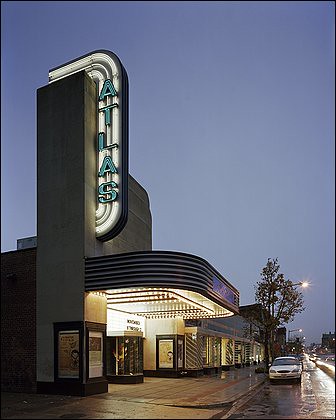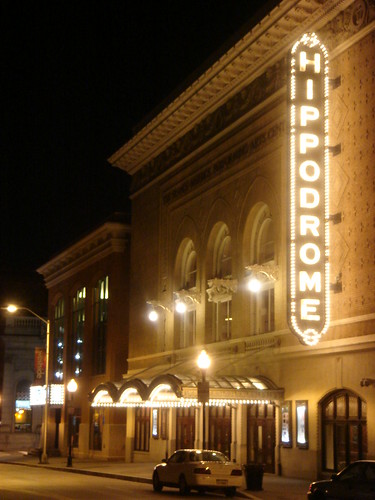Musing on the economic impact of cultural and sports events

Atlas Performing Arts Center. Photo: Michael Moran for APAC.
In my early involvements, I have an email from 2002 to the people doing the plan for the revitalization of H Street, making the point about anchors and clusters and how itinerant patrons of museums (then the Children's Museum was on H Street) or arts performances (the H Street Playhouse, now the Anacostia Playhouse had opened and the vacant Atlas Theater was about to be rehabilitated, which four years later reopened as the Atlas Performing Arts Center) would in turn spend money at restaurants and ideally related retail, thereby expanding the array of viable businesses available to local residents also.
Of course, there comes a point where that can be "too much of a good thing," which is the case of touristified places like Pike Place Market in Seattle, Ferry Building in San Francisco, or increasingly entire cities like Venice or Barcelona.
But mostly, such patronage is welcomed, even if often, such as associated with mega events like the Olympics, or smaller sports events like the basketball all star game in the US or the National Football League Super Bowl, it is over-touted.
-- "Not enough time for a) 2024 DC-Baltimore Olympic Bid (to make sense)," 2014
-- "Big sporting events (World Cup/Olympics), economic development and trickle down economics," 2014
-- "Super Bowl," 2016
-- "More need for economic revitalization planning/linkage with sports stadiums: Las Vegas (+ Houston and the Super Bowl)," 2017
-- "Minneapolis Super Bowl: Urban Revitalization and Transformational Projects Action Planning," 2018
1. Interestingly there is an article in the New York Times about the Women's Soccer World Cup, and the upcoming game between France and the US. Residents of Reims, the city where the match will be held, wanted the US to be the opposing team because they could expect a fair number of attendees as a result ("U.S. Might Be the World Cup's Best Team. It Is Definitely the Best Draw").
The article made an interesting point, that attendees of Men's soccer matches don't spend much money while attending events, other than on alcohol, but Women's soccer matches tend to draw families and they spend more money on other things besides drinking.
This gets at a point I make a lot about sports tourism, that it often is focused specifically on attending the event, and attendees don't make a point of going to non-sports related attractions or spend money other than on lodging, food and drink.
It looks like attendees of Women's World Cup Soccer are different.
 2. The Hippodrome in Baltimore was renovated not quite 15 years ago, and it's beautiful. But it's in a part of the city, Westside, that still doesn't have a lot of "indigenous" night time establishments, and with the redo, they didn't put in substantive space for food and beverage--in fact in the beginning they touted access to food trucks.
2. The Hippodrome in Baltimore was renovated not quite 15 years ago, and it's beautiful. But it's in a part of the city, Westside, that still doesn't have a lot of "indigenous" night time establishments, and with the redo, they didn't put in substantive space for food and beverage--in fact in the beginning they touted access to food trucks.The Baltimore Business Journal has a story, "'Hamilton' run will ripple beyond Hippodrome's doors," about the positive impact on restaurants from the increased patronage of the theater during the run of Hamilton. From the article:
Lin-Manuel Miranda's massively popular musical about founding father Alexander Hamilton is expected to draw nearly 80,000 people over the course of its 32-show run at the Hippodrome. And that crowd is likely to ripple beyond the theater's doors.3. Getting back to my original email, this raises the point that I have mentioned many times in many contexts that you need to do broader ranging planning in association with the creation or improvement of anchors, to ensure the greatest economic impact more quickly.
Across the street, Forno is already reaping the benefits. Dinner reservations at the rustic Italian restaurant have been booked solid since a month ago for the four weeks that Hamilton is playing, general manager Ricky Johnson said.
It's not unusual for Forno to be busy whenever there's a Broadway show in town. The Hippodrome is the biggest driver of business at the restaurant, Johnson said, and — as one of the only sit-down restaurants near the theater — it is often packed on nights that there are shows.
The difference this time around is the length of the musical's run and the timing: right in the middle of what is usually a summer doldrums. …
"Hamilton" has had a marked effect in other cities that have hosted the show. In Chicago — where the musical has been performed more than 1,000 times since opening in 2016 — the economic impact is estimated at $1 billion.
Investing in adding restaurants and such in association with such programs should be a rote part of such initiatives and it usually isn't. From the BBJ article:
The restaurant's busyness is proof to Hippodrome President Ron Legler that other businesses can succeed on the same block as the theater, which is located near Lexington Market in Baltimore's Bromo Arts and Entertainment District. He's been courting restaurateurs for the building that used to house Alewife, which shuttered last summer at the corner of Fayette and Eutaw streets.Although granted, this is tough to do because when a new attraction opens, business tends to be slow, and there isn't enough non-attraction business to smooth out peaks and valleys. Somehow there needs to be a way to provide subsidy assistance to such establishments in the interim.
"We don't have enough restaurants in the Bromo District — we need more retail, restaurants and those things here," Legler said. "Even our Panera Bread, which is across the street — whenever a Broadway show comes in, you feel like you're in New York City but you're at Panera. It's packed."
It wasn't with DC's Convention Center, and 15 years later the area around it has plenty of room for improvement, although things have started happening of late ("The time to plan for retail in and around the Convention Center was long before it opened in 2003 and certainly before 2015," 2015).

Buildings on Kennedy Street NW, after the multi-million dollar streetscape improvement program.
It isn't with streetscape improvement projects in emerging districts, but imagine if the streetscape project was accompanied by investments in façade and signage improvements for business, recruiting to fill holes in the business mix, technical assistance to the businesses for improvements, etc. ("To accelerate commercial district improvement you have to do more than build the one shiny new thing," 2018).
Trickle down improvement takes decades. Focused assistance speeds up this process considerably.
4. Planning for seasonality. The BBJ article makes an important point too, that "Hamilton" is popular and will draw attendees regardless, but because it's scheduled in the summer, when normally the Hippodrome isn't that active, it will boost revenues beyond what is normally expected during the summer. More places should focus on creative programming and planning to boost patronage throughout the year, even if that is considered to be "countercyclical."
5. Using big events to draw new audiences. The BBJ article discusses how the Hippodrome added subscribers because they had to be subscribers to get tickets to the Hamilton show. But at the same time they've been focused on keeping them as subscribers for next season and presumably beyond.
Plus, they've done some interior fixing up and serious renovation including the expansion of the M&T Pavilion.
Some places, in planning, do this kind of simultaneous development, most don't.
5. Extending the appeal of attractions through additional events. From the BBJ article:
The Hippodrome is also partnering with neighbor Everyman Theatre to host "Hamiltunes," a karaoke night aimed at "Hamilton" fans. The event, scheduled for Monday, is intended to drum up excitement for the show with sing-alongs of popular songs from the show. (Fittingly, tickets to "Hamiltunes" cost $17.76.)This is what a food processing company might call "line extension," such as how Heinz started selling mustard, to play off their success in selling ketchup.
A lot of the time this can be done badly, but when it's done well it helps to leverage the event or attraction and extend your penetration of the customer base.
Labels: cultural planning, economic development planning, sports and economic development, urban revitalization



0 Comments:
Post a Comment
<< Home